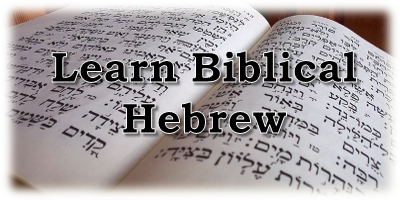Learn Hebrew Verb Conjugations - Verb Voice
In Verbs part 1 we learned that each Hebrew verb identifies;
- Person (first, second or third) of the subject of the verb
- Gender (masculine or feminine) of the subject of the verb
- Number (singular or plural) of the subject of the verb
- Tense (perfect or imperfect) of the verb
- And sometimes the gender and number of the object of the verb
In the next couple of lessons we will learn that each Hebrew verb also includes the following.
- Voice (active, passive or reflexive) of the verb
- Mood (simple, causative or intensive) of the verb
Hebrew verbs have three voices - active, passive and reflexive. In the active voice the subject of the verb is imparting the action of the verb. For instance, in the phrase קצר יעקב (qatsar ya'aqov) Jacob is performing the action of the cutting - "Jacob cut" (In Verbs part 1, all of the verbs learned there are in the active voice). In the passive voice the action of the verb is imparted on the subject of the verb so, in the phrase נקצר יעקב (niq'tsar ya'aqov) the action of cutting is imparted on Jacob - "Jacob was cut." In the reflexive voice the action of the verb is imparted on the subject of the verb by the subject of the verb. In the phrase התקצר יעקב (hitqatser ya'aqov) Jacob performs the action of cutting onto himself - "Jacob cut himself." Below is a chart with the conjugations of the active, passive and reflexive verb voices of קצר in the perfect tense.
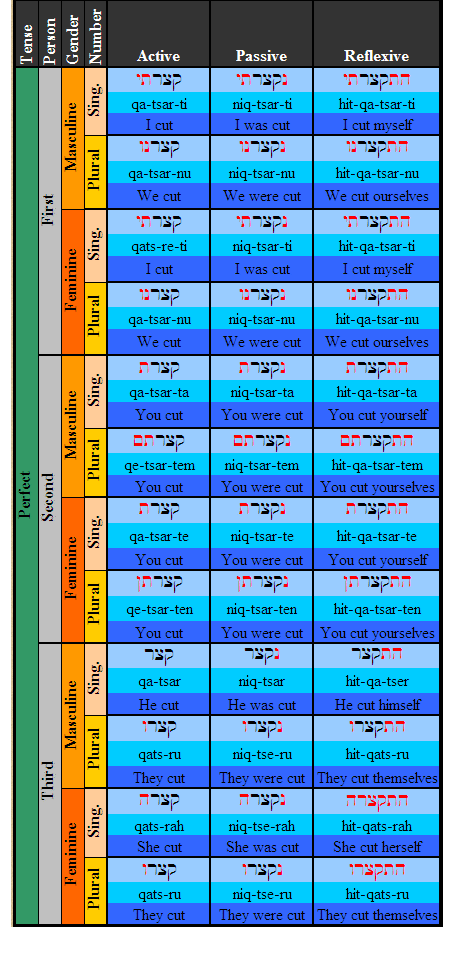
Generally speaking the passive voice verbs in the perfect tense are identified by the prefix נ (nee) and the reflexive voice verbs in the perfect tense are identified by the prefix הת" (heet).
However, when it comes to the passive voice in the imperfect tense the only difference between the passive and the active is a change in the vowel sounds. Reflexive voice in the imperfect tense does not include the first letter of the reflexive prefix - ה, instead the second letter - ת, is placed after the prefix identifying the subject of the verb. The chart below includes the active, passive and reflexive conjugations for the verb קצר in the imperfect tense.
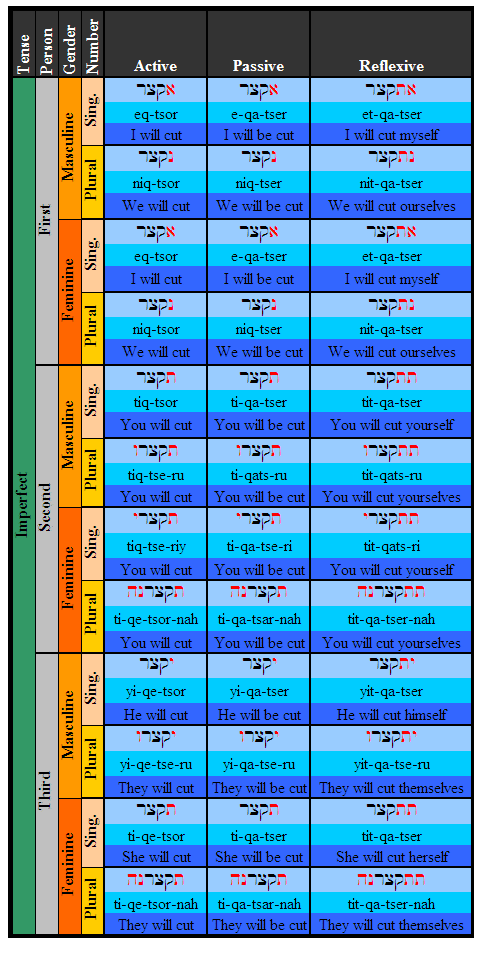
The first time a person is confronted with these various conjugations of a verb they feel overwhelmed. Do not let this frustrate you as there are a few of things to keep in mind.
Some of the more common conjugations will be easily recognized simply because of the extensive number of times they are used in the text. For instance the verb conjugation ויאמר (vay-yo-mer) meaning "and he said" is used 2084 times in the Hebrew Bible (ten times in Genesis chapter one alone).
The vast majority of the verbs in the Hebrew Bible are in the pa'al (simple, active) form which is the simplest form of the verbs.
There are several resources available to assist the Hebrew student to easily identify these conjugations (more on this in a later lesson).
Learn Hebrew Verb Conjugations - Verb Moods
Simple Mood
Hebrew verbs have three moods - simple, causative and intensive. The most common mood in Biblical Hebrew is the simple and refers to verbs of simple action. The three voices we learned in the previous lesson are in the simple mood. Each of these verb forms have a name.
Simple active - pa'al (Also called the Qal)
Simple passive - niphal
Simple reflexive - hitpa'el
Causative Mood
In the causative mood and active voice the subject of the verb causes the action of the verb - "Jacob caused him to cut a tree." In the causative mood and passive voice, the action is caused to be imparted on the subject of the verb - "Jacob was caused to be cut." Each of these verb forms also have a name.
Causative active - hiphil
Causative passive - hophal
Intensive Mood
The intensive mood intensifies the action of the verb. When the verb is used in the intensive it may be translated as "slashed." "Jacob slashed a tree" is intensive mood and active voice and "Jacob was slashed" is the intensive mood and passive voice.
Intensive active - pi'el
Intensive passive - pu'al
All of the verb forms covered thus far are available on this PDF chart.
Again, do not let all of this discourage you, your objective at this point is to become familiar with the concepts and as you continue to work with the Hebrew text using the various resources available to you, you will become more comfortable with them.
Learn Hebrew Verb Conjugations - Participles
In our previous lessons concerning verbs we learned that verbs have two tenses, perfect and imperfect. A Hebrew verb participle is a third tense of a verb and simply identifies the action of a verb. As an example, in the sentence קוצר יעקב (qotser ya'aqov) the verb qatsar is written as a participle and the sentence would be translated as "Jacob is cutting." Particples do identify the gender and number of the subject of the verb but it does not identify the person (1st, 2nd or 3rd). Generally speaking the participle is translated in the present tense, but keep in mind that the Hebrew verb is not related to time but action.
As I have stated, a participle identifies an action, but it can also be used for one who performs that action. For instance, when the root רעה (ra'ah), meaning "to feed," is written in the masculing, singular participle it becomes רועה (ro'eh) and means "feeding," such as we find in Genesis 30:36, which states that "Jacob was feeding the remainder of Laban's flock." But, this same participle can mean "one who feeds," a shepherd, as we see in the 23rd Psalm, "Yahweh is my shepherd." The most common form of participles is the pa'al form and below is a chart of these participles.
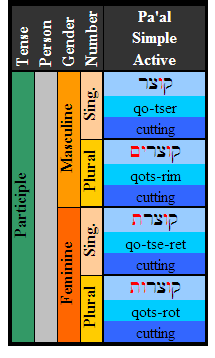
Learn Hebrew Verb Conjugations - Imperatives
The imperative form of the verb identifies an action to be performed in the context of a command. Just as with the participle, the imperative identifies the gender and number of the subject of the verb but not the person. An example of an imperative can be found in Genesis 28:2 which says, קום לך (qum lakh) meaning "rise, go." The word קום is the imperative form of the root קום (qum) meaning "to rise" and the word לך (lakh) is the imperative form of the verb הלך (halakh).
In most cases, the three letters of the root are retained whenever the verb is conjugated. However, there are some exceptions such as with the verb הלך (halakh) which drops the letter ה (ha).
Below is a chart of the imperative forms of the verb in the pa'al form (At the conclusion of the verb lessons there will be a detailed chart which will include all voices and moods for all forms of verbs).
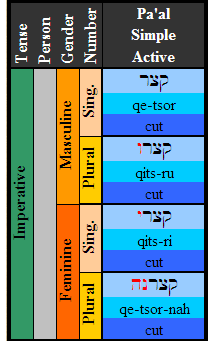
Learn Hebrew Verb Conjugations - Infinitives
The infinitive verb can take on two different forms, the construct and absolute.
The construct identifies a simple action such as we find in Genesis 8:12 where the infinitive שוב simply means "return." The letter ל, meaning "to" is commonly prefixed to to construct infinitive such as the word ולמשול (ve-lim-shol, Genesis 1:18) meaning "and to regulate."
The absolute intensifies another verb which follows it. For example, in Genesis 2:17 is the phrase מות תמות (mot tamut) where the infinitive absolute מות (mot - die) intensifies the following verb תמות (tamut - you will die).
The subject of the verb is identified by a pronoun suffixed to the infinitive. An example is found in Genesis 3:5; אכלכם (akhal'khem). The verb אכל (akhal) meaning "to eat" is followed by the suffix כם meaning "you."
Below is a chart of the infinitive forms of the verb in the pa'al form.
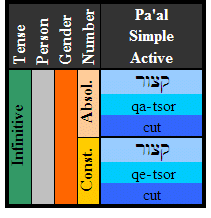
Learn Hebrew Verb Conjugations - Resources
A Hebrew Verb Chart, available in PDF and includes all the conjugations of the verb qatsar however, it is only a guide as there are many different variations on the spellings of verb conjugations depending on the types of letters the verb is spelled with.
The best resource for deciphering Biblical Hebrew verbs is Benjamin davidson's Lexicon. When you come across any word with its prefixes and suffixes in the Hebrew Bible and are not sure of its meaning, you can look up that word in the lexicon alphabetically and it will give you its root and define all of the prefixes and suffixes.
The Torah: A Mechanical Translation is the only Bible translation that identifies all aspects of the a Hebrew verb (person, gender, number, tense, voice and mood)within the word itself through its unique style of translating. This tool is an excellent resource for anyone learning Hebrew. Another good book is 501 Hebrew Verbs which provides a chart, similar to the pdf file above, for all the various conjugations of 501 (most common) verbs. The only drawback to this book is that it is more oriented toward Modern rather than Biblical Hebrew.
Another great resource is a good Bible Program like Logos or Bibleworks. These programs will include the Hebrew text of the Bible and will identify the root word, prefixes and suffixes added to each word.
Go to Lesson #17



